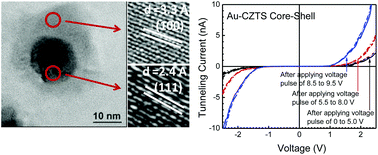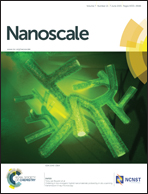Multilevel memristor effect in metal–semiconductor core–shell nanoparticles tested by scanning tunneling spectroscopy†
Abstract
We have grown gold (Au) and copper–zinc–tin–sulfide (CZTS) nanocrystals and Au–CZTS core–shell nanostructures, with gold in the core and the semiconductor in the shell layer, through a high-temperature colloidal synthetic approach. Following usual characterization, we formed ultrathin layers of these in order to characterize the nanostructures in an ultrahigh-vacuum scanning tunneling microscope. Scanning tunneling spectroscopy of individual nanostructures showed the memristor effect or resistive switching from a low- to a high-conducting state upon application of a suitable voltage pulse. The Au–CZTS core–shell nanostructures also show a multilevel memristor effect with the nanostructures undergoing two transitions in conductance at two magnitudes of voltage pulse. We have studied the reproducibility, reversibility, and retentivity of the multilevel memristors. From the normalized density of states (NDOS), we infer that the memristor effect is correlated to a decrease in the transport gap of the nanostructures. We also infer that the memristor effect occurs in the nanostructures due to an increase in the density of available states upon application of a voltage pulse.


 Please wait while we load your content...
Please wait while we load your content...